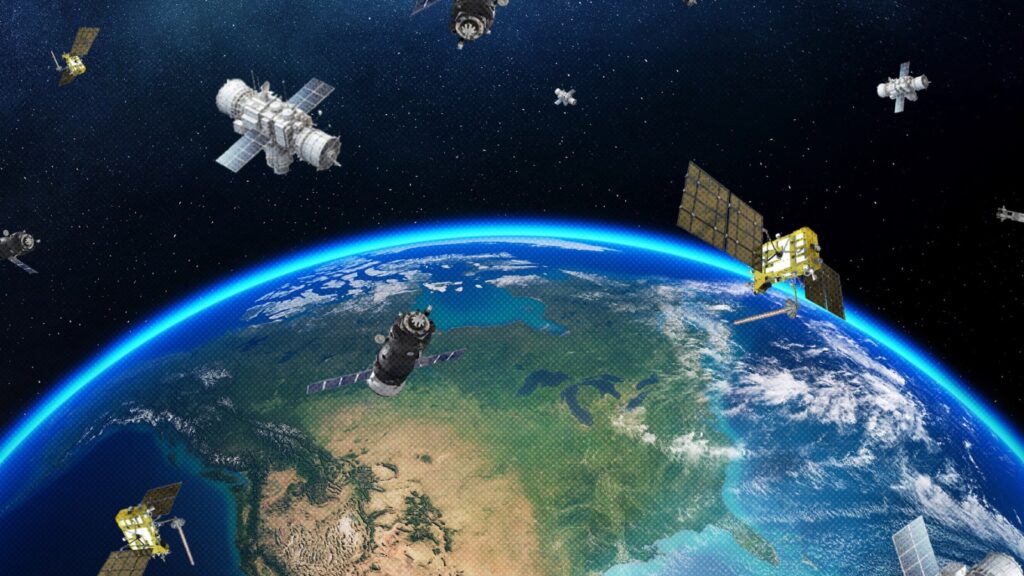It’s a Bird, It’s a Plane, It’s Space Trash!
O
n the evening of March 25, 2021, Karen Levy relaxed with some friends on her front porch in Seattle. They were having dinner, enjoying the cool evening weather and cloudless skies, when they noticed something odd. A bright squadron of fiery objects had invaded the night sky and was careening across it.
“Holy smokes, what is that?” thought Levy, a University of Washington epidemiologist.
She wondered if they could be UFOs. Her kids ran outside to see what the commotion was about, and all they could do was gawk, as the unusual aircraft or spacecraft or whatever they were continued on their mostly horizontal path.
“I’ve never seen anything like that in my life,” Levy tells me.
Before the objects and their smoky trails flew out of sight, Levy pulled out her phone and snapped a photo, which she posted on X. Within a minute, it was all over. The mysterious objects vanished. And then the sky seemed empty once again, as if nothing had happened.
Just a few miles away in Seattle, astronomer James Davenport was putting his kids to bed when his phone exploded with messages from a flood of people asking him about the strange flash in the sky. He went out to see it. “It was both beautiful and apocalyptic,” Davenport says. He remembers hoping the flaming fragments weren’t the remnants of a plunging plane.
Before that night ended, experts had figured out that what Davenport, Levy, and many others in the Pacific Northwest had seen were fragments of the upper stage of a SpaceX Falcon 9 rocket. After deploying Starlink satellites into orbit as planned, the four-ton, 45-foot rocket body — which is larger than a school bus — began plummeting out of control back toward Earth.
The massive rocket husk quickly heated up to some 3,000 degrees Fahrenheit and then broke up in the atmosphere into large and dangerous chunks, still on their earthbound trajectory, eventually strewing shrapnel across central Washington state, including on a Grant County farm. Fortunately, no one was hurt.
Like with all objects orbiting or falling back to Earth, the U.S. Space Force, which emerged from under the wing of the Air Force five years ago, tracked the rocket’s descent with a network of ground antennas, publishing the data in its database. Aerospace Corp., a federally funded research and development center in El Segundo, California, also followed the reentry.
Turns out humans leave trash everywhere we go — and just like when we throw garbage out a car window, there are long-term impacts of leaving behind rubbish in the high-traffic lanes of the atmosphere. “The sky always seems so static and far away,” Davenport says. “This changes your perspective and makes you think, ‘It’s actually an environment where there’s pollution and we have to protect it.’”
Back in NASA’s heyday, rocket launches used to draw huge crowds. But today, it’s cheaper to launch them, so hundreds blast off annually without much fanfare, carrying their payloads into orbit. Whether we’re aware of it or not, we’re all increasingly dependent on satellites for our phones and apps and for myriad other needs, like GPS, streaming TV, weather forecasts, and even banking. Around 10,000 satellites silently circle the Earth, hundreds of miles above, with many of them coming from the U.S., and Starlink now accounts for the majority of those. We’ll need to keep deploying at least some new satellites and spacecraft every year, but business as usual doesn’t seem particularly safe or environmentally friendly. Big chunks of space trash now crash on Earth multiple times a week. Some 450 large intact objects reentered the atmosphere, out of control, between 2008 and 2017 — a stunning 900 metric tons of material, according to a recent study. There’s a one-in-four chance someone on the ground will be killed in the next decade by falling rocket debris, according to other new research.
Just one errant rocket’s tragic crash in a populated area would derail the space industry for years. Or a rocket body colliding with other orbiting objects, creating gazillions more pieces of hazardous space junk, could disable many other satellites, and suddenly many of our smartphone apps would be rendered useless. It’s an open question whether national and international organizations can address the situation before space has its Exxon Valdez moment.
SOMETIMES FALLING SPACE GARBAGE makes the news, when chunks of spacecraft crash near heavily populated areas or when the plummeting spacecraft are really large. SpaceX launches many rockets these days, and its March 2021 rocket drew attention when it broke up and descended near Seattle and Portland. And in July and November 2022, the Chinese space agency rockets that boosted China’s Tiangong space-station modules rained down debris near the Philippines in the South China Sea. Previous Chinese rockets left space junk to fall near the Maldives in May 2021, and a year earlier, debris passed above Los Angeles and New York City before splashing into the Atlantic. A big piece of a SpaceX spacecraft landed on an Australian sheep farm in July 2022, but no sheep were harmed. With such uncontrolled reentries, as these are called, fragments that make it through the atmosphere can land almost anywhere, not necessarily in remote, unpopulated regions.
Federal agencies are finally paying attention, taking steps to limit how much dangerous space trash companies generate. The Federal Aviation Administration is charged with regulating launches and reentries by U.S.-based organizations, and has noted the rapid growth of junk in low Earth orbit and increasing risks of space collisions that would beget more dangerous pollution — like the space crashes dramatized in the movie Gravity. To mitigate the situation, last September, the FAA proposed a new rule: U.S. space companies have to properly dispose of their upper-stage rockets, either by bringing them down safely or boosting them up into a so-called “graveyard orbit,” where there’s more space and not much stuff to crash into. Once the FAA makes it official, letting rockets fall or leaving them in congested orbits can no longer be the norm. As if to underscore the problem, the day after the agency proposed the rule, a SpaceX Falcon 9 made an uncontrolled reentry, leaving trash in the South Pacific Ocean.
No one has been injured or killed by falling rocket debris — yet. “The number of rocket launches is increasing, and the population is increasing, so the casualty risk in aggregate of somebody getting killed is pretty high. It’s just a matter of time, if practices are not changed,” says Aaron Boley, a planetary scientist at the University of British Columbia. “We have to be more mindful of what we launch.”
Boley is also a co-founder of the Outer Space Institute, a network of researchers who advocate for the sustainable development of space. He’s out to refute the common misconception that space is so big that we can do whatever we want with it, leaving trash willy-nilly, with no consequences.
Last year, Boley and his institute colleagues published an open letter calling for international space powers to come to an agreement on reentries, to ensure that falling objects won’t cause damage or casualties. Its many signatories included a Nobel laureate, retired astronauts, and former NASA officials, but not sitting officials at NASA, other space agencies, the United Nations, or space companies. Boley and his colleagues also co-authored a paper then, finding that people in latitudes of the Global South have a higher risk of getting hit by rocket chunks than those in the regions launching them, like the U.S., China, and Europe. In short, people with little involvement in the causes of the problem are bearing the brunt of the junk, not unlike other environmental-justice issues.
The new FAA rule applies only to U.S.-based companies like SpaceX, aerospace heavyweight Northrop Grumman, and a joint Boeing-Lockheed venture called the United Launch Alliance, but they’re not the only ones producing the outer-space litter. Chinese rockets, especially the 20-ton Long March 5B, have drawn attention because of their size and mass. In general, the bigger the rocket, the bigger the pieces that come hurtling back down to the ground. Neither SpaceX nor the Chinese National Space Administration responded to Rolling Stone’s requests for comment, and the FAA declined to make a statement about the rule’s specifics. Last October, the FAA issued a report to Congress, specifically singling out the debris risks from not just SpaceX’s rockets but also the company’s 5,000-plus Starlink satellites, humanity’s largest artificial constellation by far, since those broadband internet satellites will one day become defunct and fall from the sky. SpaceX disputed that assessment in a letter, claiming that its satellites completely burn up during reentry. (Anything low enough in the atmosphere will feel aerodynamic drag, or air resistance, slowing it down so that it falls and burns up.)
Researchers such as Boley and veteran aerospace engineer Luciano Anselmo, who’s also analyzing the problem, at the Space Flight Dynamics Laboratory in Pisa, Italy, see the risks as worrisome, and say they’re likely to ramp up quickly over the next couple of decades. “The potential risk from a single object is very, very low,” says Anselmo, a Space Flight Dynamics Laboratory in Pisa, Italy. “The problem must be considered at the global level, as an integral of all the reentries occurring day after day, accumulating risk over time.”
During his recent study, Anselmo and his colleagues counted about 65 uncontrolled reentries of large intact objects during 2018, with three of them having a mass exceeding five metric tons. They calculated that there’s a three percent chance every year that a person could be injured or killed by reentering fragments of orbiting objects. Two-thirds of that risk comes from rocket bodies, with most of the rest from satellites. Those are current risks; they could rise to 20 percent annually if things don’t change, Anselmo says. A single airplane hit by falling space shrapnel could result in hundreds of deaths, too, and close calls would result in closing airspace and airline disruptions — which are all likely reasons for the FAA’s concern about these threats. Spain already had to close parts of its airspace in November 2022, when descending fragments of a huge Chinese rocket flew overhead.
NOT ALL ROCKETS ARE ALIKE. Nevertheless, most have two or even three stages. SpaceX revolutionized the commercial space industry by developing reusable first-stage boosters, the bottom part of a rocket, which can be designed to land safely and fly again. The innovation is making launches much cheaper, and doesn’t create space trash with those stages, since they’re designed to touch down on an offshore landing platform, to be collected and refurbished. Now, other companies are following its lead, including Blue Origin, Rocket Lab, and Relativity Space.
But upper-stage rockets, which deploy payloads into orbit, are the issue here. Once that rocket stage releases its spacecraft, which goes off on its own merry way, it is designed, in many cases, to either fall back to Earth or remain circling in the atmosphere. Both can pose problems: The pieces of an uncontrolled falling rocket could crash anywhere, but letting the rocket body drift in a crowded part of space is like releasing a leaking oil tanker in an already polluted river, since the pollution will eventually become much, much worse.
Many companies already have tools they can use to abide by the FAA’s rule. The key is to design the rocket so that the engines can be reignited, pushing it down to reenter the atmosphere safely. But that comes with a cost in an already costly industry: It takes extra fuel, for one, and it can mean slightly smaller payload capacities. Some smaller rockets also could be made to break up and burn up completely, a strategy called “design for demise.”
Furthermore, the FAA includes another, future-looking option in its rule: active debris removal. That means designing spacecraft that can snag pieces of orbiting junk and move them lower into the atmosphere, so that they burn up. Space agencies and their commercial partners have already begun testing such technologies. First, there’s the Astroscale-Japan mission, also called ADRAS-J, which launched in February atop an Electron rocket. Since April, it has been attempting to safely approach (without hitting) a large piece of debris, a spent Japanese rocket that’s been in low Earth orbit since 2009, and it will inspect and image the rocket, as a precursor to a future mission that could pull it down out of orbit. Then in 2026, the European Space Agency and the company Clearspace have their own first mission planned, which will use multiple arms — like a huge space octopus — to grab a derelict rocket and remove it from orbit. They recently changed this mission’s target after an unfortunate irony, when it was itself hit by another chunk of debris.
ROCKETS ARE JUST THE MOST VISIBLE part of a much bigger space-garbage problem. Millions of pieces of smaller junk now streak through low Earth orbit at 17,000 mph. A single strike, even by something small like an old bolt, crashing into a satellite and hitting it in just the wrong spot, could render it inoperable — and create new space trash in the process. The FAA’s rule takes aim at this issue, too. If everyone were to stop polluting these orbits, then at least new launches wouldn’t exacerbate the problem.
Even if most rockets could be made to break into bits that incinerate before they hit the ground, that might be the end of the story. What if all these things burning up upon reentry constitute an environmental problem themselves?
Falling spacecraft gradually ablate — the technical term for burning up — about 40 miles above the ground, in the mesosphere, which sits above the stratosphere. The air up there is super thin. If it were as dense as ordinary air, it would fit in one square mile. That means that it doesn’t take much to disturb its chemistry, says Jonathan McDowell, a space guru and satellite expert at the Harvard-Smithsonian Center for Astrophysics who has long been tracking objects entering and reentering the atmosphere. A National Oceanic and Atmospheric Administration study last October detected aerosol particles containing aluminum, lithium, copper, and lead in the mesosphere, and it traced them to metals that vaporized during spacecraft reentry. This could pose a problem, such as if the conductive metal particulates accumulate and disrupt the Earth’s magnetosphere, a cocoon that shields us from space weather. All these spacecraft burning up could also delay the recovery of the ozone layer for decades, thanks to the buildup of aluminum oxide particles, or affect how that part of the atmosphere moderates climate change.
Researchers like Boley and Anselmo would like to see governments around the world work together to address these problems, like they did with the 1987 Montreal Protocol, which phased out chlorofluorocarbons to protect the depleted ozone layer. That kind of international agreement would make sure that low Earth orbit is usable for everyone, Boley argues. He also points to the Exxon Valdez oil spill, which befouled the Alaskan coastline and led to the adoption of double-hulled ships.
The FAA rule didn’t come from nowhere. It codifies international standards developed by space agencies from around the world through the Inter-Agency Space Debris Coordination Committee. There’s now a coordinated effort across the U.S. government, too. “This is part of an all-hands-on-deck approach, with the [Biden] administration trying to respond to the orders-of-magnitude increase of launch activity that we’ve seen in the past few years, primarily because of the reusability of SpaceX’s Falcon 9 rocket,” says Michael Runnels, a business-law expert at California State University in Los Angeles who has written about the ways fees like taxes could help the cause.
“We need to have a tough conversation, a conversation people don’t want to have. How many satellites can we put up and sustain?” Boley asks. “There has to be some limits, but where those limits come in is the hard question.”
An answer can’t come soon enough. Just in March, a two-pound piece of space trash smashed into a home in southwest Florida, plowing through the roof and two floors. The homeowner was away, but the hunk of metal nearly hit his son.
NASA experts already know where that space junk came from, dating it back to the agency’s own littering three years earlier, and the Florida family is now suing NASA for damages. In March 2021, around the same time SpaceX’s rocket bits tumbled above Seattle, NASA used the space station’s robotic arm to discard a 5,800-pound pallet of old nickel-hydrogen batteries, saying that they’d simply orbit for a couple years before burning up harmlessly in the atmosphere.





